Bliss Bennet's Blog, page 6
March 8, 2017
Ackermann’s Fashion Plates January 1813
I’m always taken by the color words from the Regency period. “Morone” is the color for January 1813, used to describe the “Morning Walking Dress” in Plate 5. As one might surmise from the print, “morone” is a (now obsolete) variant of maroon, a “deep crimson colour,” according to the OED. In a citation from 1836, the shade is described as “the colour of the unripe mulberry.” When trimmed with spotted ermine, as the robe pelisse in this plate is, it makes me think of all those costume robes for kings that we used to dress up in as children. Do you think the combination had the same connotation of royalty for Regency fashionistas?

Vol. IX, no. xlix, Plate 5

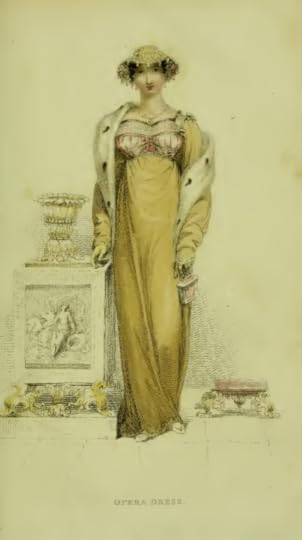
Vol. IX, no. xlix, plate 6
Both dresses are credited to one Mrs. Gill, Cork-street, Burlington-Gardens; for “the superior elegance” of her dresses she “has long stood distinguished and unrivalled.” A decidedly English name, Mrs. Gill. Perhaps all the Regency novels that portray the most sought-after dressmakers as French (or as pretending to be so) do not have it quite right?
This month’s “Patterns of British Manufacture” are not fabrics, but rather decorative papers. The sample is difficult to see, but #4 is rice paper, “imported from the East Indies.” The OED gives 1810 as the earliest mention of “rice paper” in English, so its appearance in Ackermann’s Repository (and at Ackermann’s shop) illustrates how up to the minute the magazine was in bringing innovative goods to the attention of its fashionable readers.
The paper, which comes in multiple colors, is recommended for fashioning paper flowers, which will “possess a superior degree of delicacy, and a nearer approach to nature” when constructed from such thin, translucent paper.
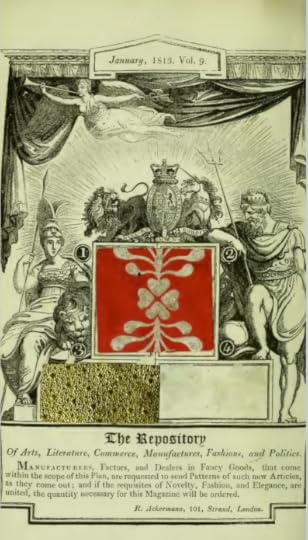
Vol. IX, no. xlix


March 1, 2017
Ackermann’s Fashion Plates December 1812
After a bit of a hiatus, to concentrate on the publication of A Lady without a Lord, I’m back with the latest installment of the great Ackermann’s fashion print project!
A Regency evening gown with pockets? I’d never imagined a fancy ball gown would ever contain a pocket, but December 1812’s issue of Ackermann’s proves me wrong. Not only does the Evening Dress in Plate 41 contain pockets, said pockets are even ornamented with crimson and gold bows! I would have thought a bow on a pocket would ruin the effect of the long line of the Regency dress. Would you adorn your gown with a pocket ornament, if you were wearing such a dress?

Vol. VIII, no. xlviii, plate 41 December 1812


In addition to the description of the Morning or Carriage Costume in Plate 42, Ackermann’s columnist reports that “it is sometimes fashionable to adopt the muff of silver bear, or blue fox,” which is “making great advances towards a fashionable celebrity.” Muffs and tippets of the same fur are also recommended, as are “velvet hunting caps, trimmed with fur.” Does the “silver bear” refer to the now-extinct Mexican grizzly bear, I wonder? And what species is the “blue fox”? An Arctic or Siberian fox? The lady in the print has a cape trimmed with “Angola trimming fur”—from the Angola Colobus monkey? Did adorning themselves with exotic furs make Regency-era women curious about the distant countries from which they came, do you think? Or the fauna native to them?
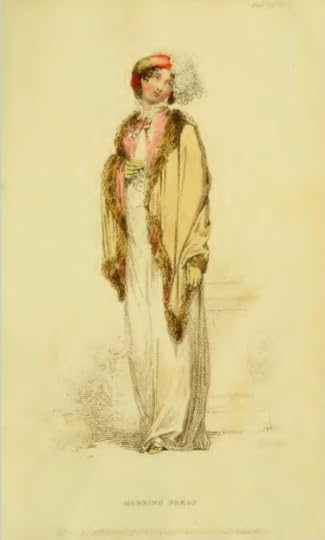
Vol. VIII, no. xlviii, plate 42 December 1812
This month’s issue includes no fabric samples, only an elaborate pattern for needlework. To decorate a waistcoat or the hem of a ball gown? Those flowers look quite modern to me!

January 19, 2017
2017 Historical Romance Reading Challenge
It’s been a hectic end of 2016, and a busy beginning of 2017 for me. I’m just starting a term as President of the New England Chapter of Romance Writers of America; I’m finishing the final edits on A Lady without a Lord, the much-delayed third book in The Penningtons series (yeah!); I’ve been working with my web designer to implement an updated look for my author web site; and I’m shivering in my socks because of ongoing intermittent problems with the heating system in our house (we’ve been told that the part arriving tomorrow will definitely fix the problem this time…). But I wanted to put up this quick blog post, just to let everyone know that I haven’t fallen off the earth, and will be continuing on with my Ackermann’s fashion plate project starting next week.
I also wanted to ask if anyone would like to join me in participating in the Historical Romance Reading Challenge of 2017? Sponsored by the I Heart Romance & YA Blog, the challenge has different levels of commitment (amusingly linked to different aristocratic titles), so you can pick how few (or how many) books you’d like to aim for this year. I’m going for the “Countess” title, which means I have to read between 16-25 historical romances before the end of 2017. It’s totally do-able, unless 2017 turns into another year from family life hell as 2016 did (crosses fingers and hisses).
I plan to report back on the blog here about my historical romance reading at the beginning of each month, and would love to hear from others about what you’re reading, too!
December 15, 2016
A Lady without a Lord cover reveal!
So excited about the cover for the latest book in the Penningtons’ series, A Lady without a Lord! My cover model is an actual world-ranked fencer, and gave me advice about the fencing scenes the book…
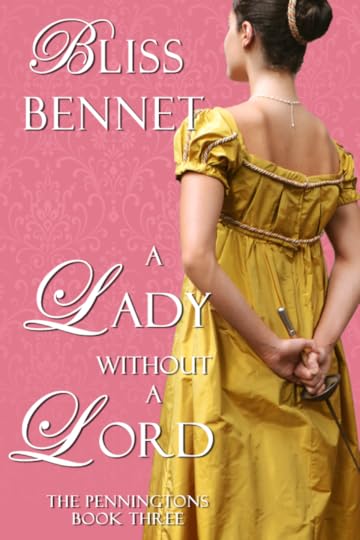
Lady will be published this coming Valentine’s Day. The e-book is currently available for pre-order at these online retailers:
• Kobo
Enjoy!
October 19, 2016
Ackermann’s Fashion Plates, November 1812
November’s fashion plates, which feature an Evening Dress and a Parisian Opera Dress, are accompanied by “General Observations and Description of the Fashions for Autumn.” These observations include few of the strictures about dress that were common in early issues of the magazine; instead, they truly do just “describe” what is currently being seen about town.
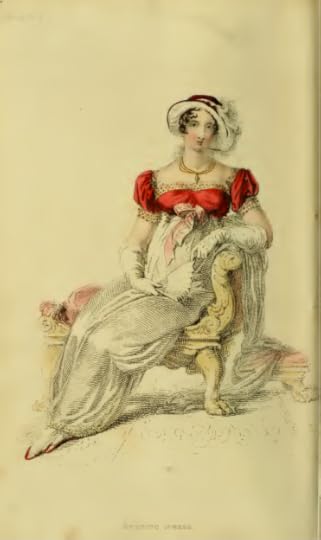
Vol. VIII, no. xlvii, page 301, plate 32

Vol. VIII, no. xlvii, page 301, plate 33
Autumn is remarkable for its diversity of fashions, our anonymous reporter notes, due to the changeful temperature of the season: “We not frequently observe the costume generally appropriated and adapted to the four quarters of the year, displayed in one day; so that the fair ovaries of the fantastic goddess have ample scope for their invention, as well as extensive encouragement for the exercise of their taste and genius.”
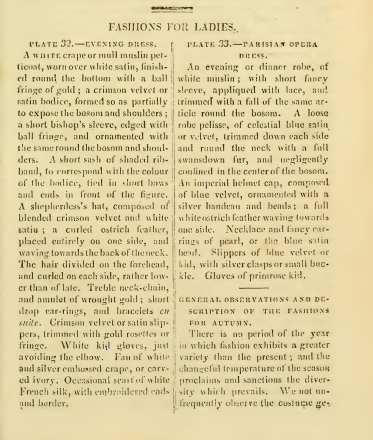
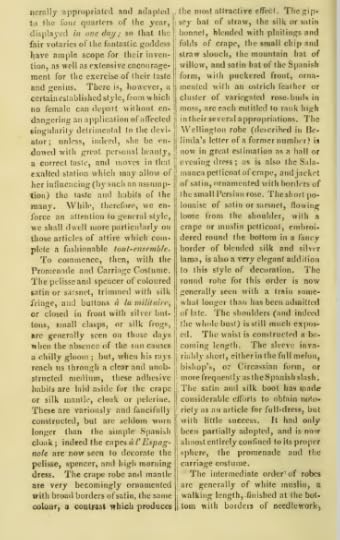
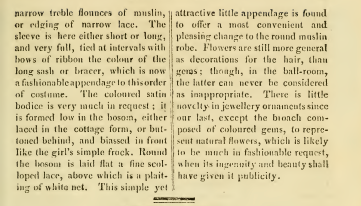
Military influences continue, with the “Wellington robe” and “Salamanca petticoat” proving particularly popular, as are buttons à la militaire. And while jewelry is never inappropriate for the ballroom, more women seem to be wearing flowers, rather than jewels, as hair adornments this season. Many women are combining the two, though: broaches of colored gems, figured in the shape of flowers, are a novelty of late.
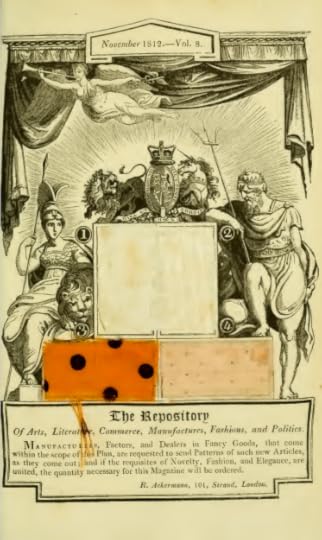
Despite my fears in last week’s post, that Mr. Ackermann had replaced his fabric samples with drawing samples, November’s edition includes the usual “Allegorical Wood-Cut, with Patterns of British Manufacture.” My eyes nearly popped out of my head when I caught sight of sample #3, which looks well-suited to an American Halloween celebration than to a Regency-era ballroom. It is a “specimen of a new and beautiful manufacture for ladies’ winter dresses,” a fabric made of materials that are never actually identified. For those not wishing to look like a moldy pumpkin, the fabric comes in a variety of other colors, too.
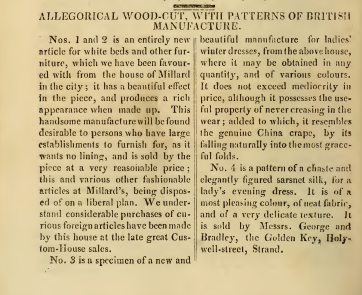
October 12, 2016
Ackermann’s Fashion Plates, October 1812
The underlying gowns of both of our fashionable October ladies are white, but added accent colors suggest the changing of the season. The Promenade Costume features a “lappelled cloak, of bright amber or yellow crape,” while the Autumnal Carriage or Morning Costume is adorned not only with a “grey satin spencer ornamented with silver cord and buttons en militaire,” but also with lemon colored shoes and a purple ridicule (reticule).

Vol. VIII, no. xlvi, page 231, plate 26
Does it strike you as strange that a fashionable lady would be wearing a rosary and cross? The one adorning the Promenade Costume above is made of coquilla nuts, from a piassava palm, native to Brazil. Was Mr. Ackermann doing a bit of self-promoting here? An article on “fashionable furniture” in the April 1812 edition reports that “R. Ackermann, having purchased a considerable quantity of this fruit… has converted the shell of it into a variety of highly ornamental articles, specimens of which may be seen at his Repository, No. 101, Strand” (240). Were rosaries and crosses among those “ornamental articles,” I wonder?

Vol. VIII, no. xlvi, page 231, plate 27

This month’s magazine does not include any fabric samples; instead, as Ackermann explains, “it has been suggested… that it might be acceptable to his subscribers, many of whom practise the elegant art of drawing, if a plate were to be introduced in each number for the advancement of the study thereof.” This month’s drawing plates feature “groups of figures for the embellishment of landscape scenery,” in particular, “gleaners and shepherds.” I wonder how many young ladies found the drawing plates helpful, and how many wished that fabric samples had been included instead?

Gleaners and Shepherds
October 5, 2016
Ackermann’s Fashion Plates September 1812
September echoes the summery mood of August’s plates featuring both Evening Dress and Walking Dress in white (crape and muslin, here). I wonder if anyone actually made a pelerine that looked like the one in the Walking Dress plate; its black lace trim puts me in mind of bat wings.

Vol VIII, no. xlv, page 175, Plate 18
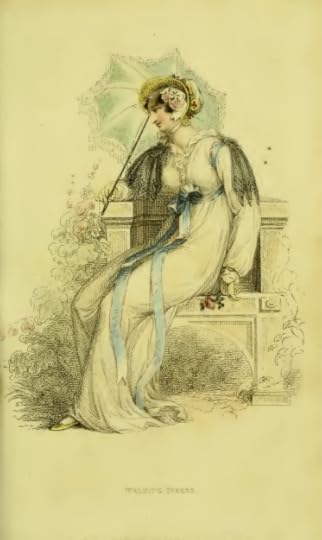
Vol. VIII, no. xlv, page 175, plate 19

Metropolitan Museum. E Pattison, manufacturer. Accession no. 2001.576a, b
Both outfits are paired with what are described as “Roman Slippers,” although I can’t spy any straps around the feet peeking out from under these floor-length gowns, can you? I can imagine something similar to these shoes from the Metropolitan Museum’s collection, dated 1806-1815. But perhaps Roman slippers are not the same as Roman sandals?
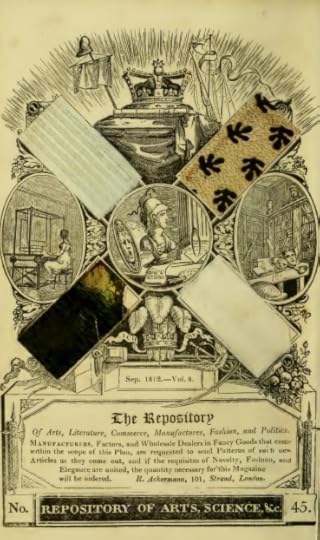
This month’s fabric samples include a piece which is not a fabric at all but rather a “beautiful fancy silver paper for ladies’ work-tables, boxes, card-racks, &c.” The actual sample, unfortunately, has deteriorated over time, and now appears mostly black. But its original form sounds quite intriguing: “When made up, it exhibits the appearance of the red sea-weed, strained on a white satin or silver ground.” I guess we will just have to picture it in our minds. Look to the sea-weed pattern of sample #2, a “sea-wood ground printed cambric,” to give you a jumping-off point for your imaginations…

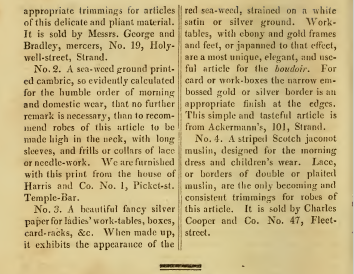
September 21, 2016
Ackermann’s Fashion Plates August 1812
August means summer, and summer means white, at least for the ladies of 1812. Both evening and promenade dresses in this month’s fashion plates feature that color, although the evening gown is of crape, while the walking costume is of jaconet or imperial cambric muslin.
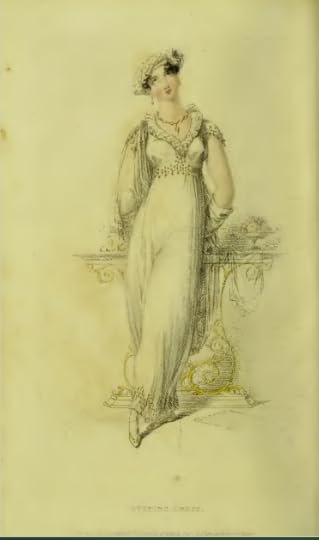
Ackermann’s Vol. VIII no. xliv, plate 11
The evening dress is described as having “Circassian sleeves,” term with which I was not familiar. So I went web searching…
Elizabeth Lewandowski’s The Complete Costume Dictionary defines “Circassian sleeve” as “Director and First Empire (1790-1815 C. E.). Worn by children in 1807, short sleeve that looped up in front” (66). But the sleeves in this Ackermann’s plate (or at least one of them, since the sleeve on the right is covered by a scarf) look to be short and triangular, with a tip pointing down toward the elbow.
Sarah at Sarah’s History Place suggests that the phrase “Circassian sleeve” has been used during different points in the Regency to describe very different types of sleeve. A 1790s reference features a three-quarter-length sleeve (which was an innovation at the time), while an 1807 mention in the October issue of La Belle Assemblée features a child’s dress with short, straight sleeves. None mention a triangle or a point.
The Circassian sleeve may just have to remain a mystery…

From THE QUAKER: A STUDY IN COSTUME (202)
And so might the “Lavinia hat” worn by the promenading lady in Plate 12. Amelia Mott Gummers’ The Quaker: A Study in Costume reports that a ” ‘Lavinia’ unbleached chip hat, trimmed with white sarcenet ribbon, was shown in 1810″ (202). The accompanying picture of said hat does not look much like the one in Ackermann’s though:
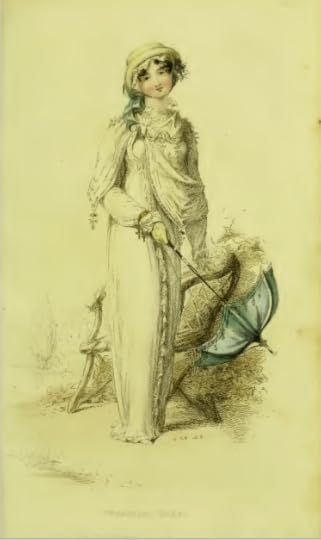
Ackermanns Vol VII, no xliv, Plate 12
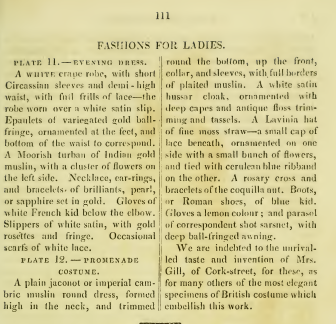
Forgot to include the fabric samples in last week’s post: apologies! August’s fabric samples, like this month’s fashion plates, contain their own share of mysteries. Sample one is described as a “veletine”—a misspelling of “velvet”? Or of “velline,” which Fairchild’s Dictionary of Textiles defines as a “a winter-weight woolen coating with curd pile surface; made in France”? Neither seems quite right for summer wear, although the description reports that the fabric is “adapted principally for the pelisse and spencer.”
The photograph of the sample, alas, is quite hard to see, but I can just make out a small pattern in the light blue, which seems to be in the weave of the fabric itself.
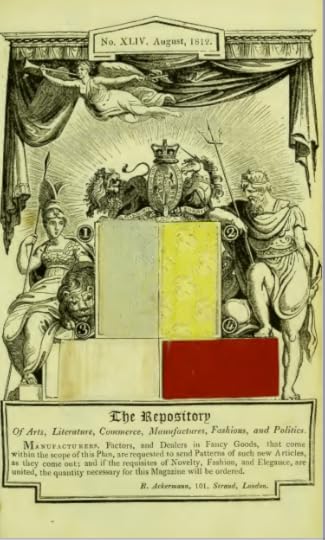
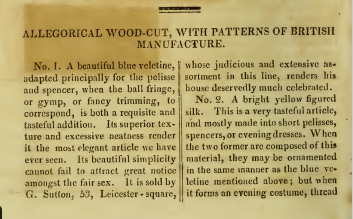
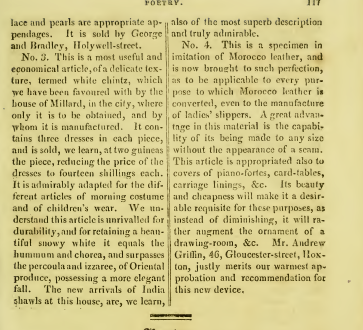
Sample 3, described as “white chintz,” is favorably compared to “hummum and chorea” as well as to “percoula and izzaree, of Oriental produce.” Fairchild’s Dictionary of Textiles tells us that “hummus,” or “humhum” is a “coarse, East Indian cotton fabric made in solid colors.” But the other types of cotton are a little harder to place. “Percoula” could be a synonym for “percale,” while “izzaree” could refer to “izarin,” “an obsolete, Indian cotton fabric” (291). But “chorea” is a complete puzzle. Any guesses?
The final mystery is in sample four, “a specimen in imitation of Morocco leather.” But Mr. Andrew Griffin, the purveyor of this “specimen,” does not mention of just what this imitation leather is made. I for one am quite curious. Too bad his shop in Hoxton is no longer in business…
September 14, 2016
Ackermann’s Fashion Plates July 1812
Well, the great Ackermann’s Fashion Plate project had to go on an unexpected hiatus this summer, due to some personal business that had to be dealt with. But with fall on the horizon, the project is back on track, with two lovely dresses from the July 1812 issue.
The first is an embroidered crepe round evening gown, featuring what are described as “melon” sleeves, with “bosom and back to correspond.” The sleeves do not puff out as much as one might expect from what we now call a “melon sleeve”:
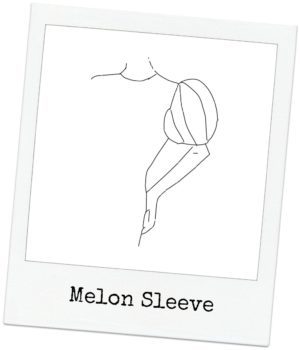
But the back bodice does look as if it is gathered in an unusual way for a Regency period dress:
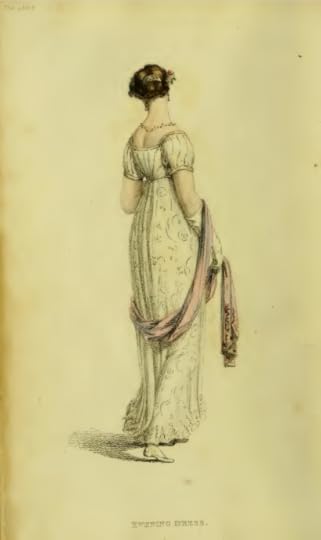
Ackermann’s Vol VII, no. xliii, plate 4
The second dress, a Promenade Gown, also features an unusual sleeve design, which the text terms a “Waggoner’s sleeve.” It appears to be a sleeve tied at regular intervals to create puffs. Sarah’s History Spot calls such a design “Mameluke” sleeves, while Trish Newbery’s Fashion Design School uses the more tasty term “bon bon” sleeves. No matter the name, the sleeve gives a medieval touch to this Regency day dress. Not sure what to say about that “Highland helmet,” though…

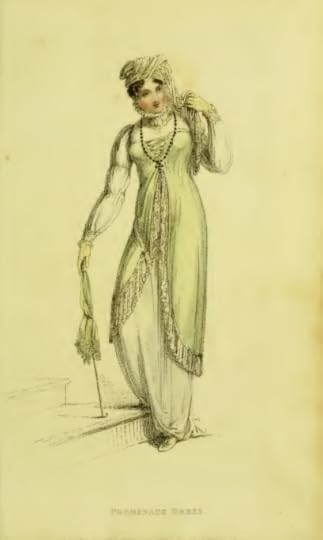
Ackermann’s Vol VII, no. xliii, plate 5

A
nd more here
June 7, 2016
Putting together a new cover, step by step
I’m in the final stages of drafting Theo Pennington’s story, book #3 in The Penningtons series. And so I’m also working on putting together a cover for the new book, which will be titled A Lady without a Lord. Curious about how a cover gets designed? Step behind the curtain, and I’ll take you on a quick tour…
For me, step one is choosing a cover model, and then sewing her a historically-accurate dress to wear. Lucky for me, my daughter has a lot of friends who are eager to brag that they’ve been featured on the cover of a romance novel…
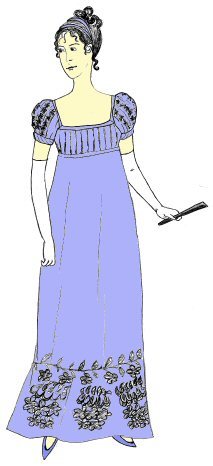 Step two is choosing a dress pattern. I like to use historical reproduction patterns so that the garments on my covers look authentic, rather than photoshopped wedding or prom gowns. For A Lady without a Lord, I chose a pattern from Nehelenia, a company in Germany. Nehelenia based their pattern on an actual dress from the period, which is in the holdings of Schloss Hohenlimburg in Westphalia, Germany. Rumor has it that the original dress belonged to Princess Agnes of Bentheim-Tecklenburg, who lived in the castle until 1830, although no actual historical documentation exists to back up the rumor. I was particularly drawn to the box pleats on the gown’s bodice—a little difficult to make, but oh, so beautiful when finished!
Step two is choosing a dress pattern. I like to use historical reproduction patterns so that the garments on my covers look authentic, rather than photoshopped wedding or prom gowns. For A Lady without a Lord, I chose a pattern from Nehelenia, a company in Germany. Nehelenia based their pattern on an actual dress from the period, which is in the holdings of Schloss Hohenlimburg in Westphalia, Germany. Rumor has it that the original dress belonged to Princess Agnes of Bentheim-Tecklenburg, who lived in the castle until 1830, although no actual historical documentation exists to back up the rumor. I was particularly drawn to the box pleats on the gown’s bodice—a little difficult to make, but oh, so beautiful when finished!
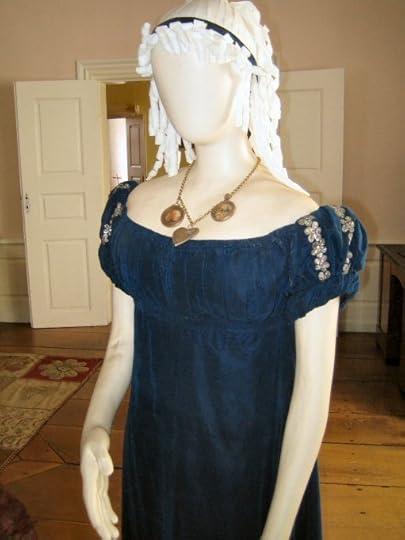
Princess Agnes’s dress, on display at Schloss Hohenlimburg
 Step three is choosing fabric and trimmings. Silk is typically my preferred fabric, as it was widely used for evening gowns in the Regency period. There are some good fabric stores near where I live, but they often don’t stock 100% silk, so I usually end up ordering my fabric online. Given my model’s coloring, I decided upon a mustardy-gold color for her gown, and selected a gold/silver/copper braid to trim its bodice and sleeves.
Step three is choosing fabric and trimmings. Silk is typically my preferred fabric, as it was widely used for evening gowns in the Regency period. There are some good fabric stores near where I live, but they often don’t stock 100% silk, so I usually end up ordering my fabric online. Given my model’s coloring, I decided upon a mustardy-gold color for her gown, and selected a gold/silver/copper braid to trim its bodice and sleeves.
 Cutting out the pattern pieces and sewing the dress comes next. The sewing for this gown presented a bit of a challenge, given that the pattern is from Germany, and had far more brief instructions than I’m used to following. Worst of all, it had no helpful illustrations! I decided to make a muslin mock-up of the bodice first, before cutting into my expensive silk, just to make sure I knew how to fold those complicated pleats.
Cutting out the pattern pieces and sewing the dress comes next. The sewing for this gown presented a bit of a challenge, given that the pattern is from Germany, and had far more brief instructions than I’m used to following. Worst of all, it had no helpful illustrations! I decided to make a muslin mock-up of the bodice first, before cutting into my expensive silk, just to make sure I knew how to fold those complicated pleats.
If I were being completely historically accurate, I would have sewn the gown all by hand. But I have to admit my handy sewing machine is just a little too tempting, especially when it comes to those long skirt seams…
Finished dress in hand, I next had to schedule the photo shoot. Quite a feat, given the busy spring schedules of my model (a graduating high school senior who is also an internationally-ranked fencer), my photographer (who also works as a psychologist), and my hair designer (my daughter, another soon-to-be high school graduate). But this past weekend, we finally managed to all gather on a sunny afternoon in my backyard, where we shot multiple versions of the same two model positions, one that echoed those of the models on the covers of the first two books in the Penningtons series.
Both A Rebel without a Rogue and A Man without a Mistress show a lady holding something behind her back. Can you see what the heroine of A Lady without a Lord has in hand?
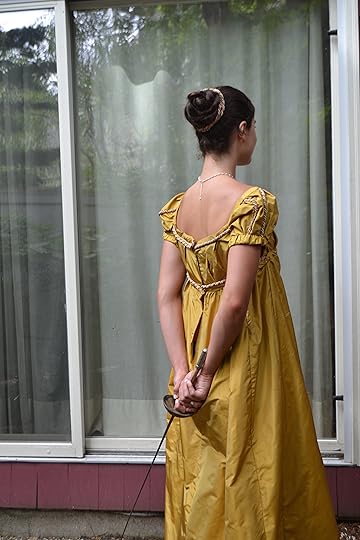
Next week, I’ll show you what happens during the cover design process after you’ve selected your cover photo.




